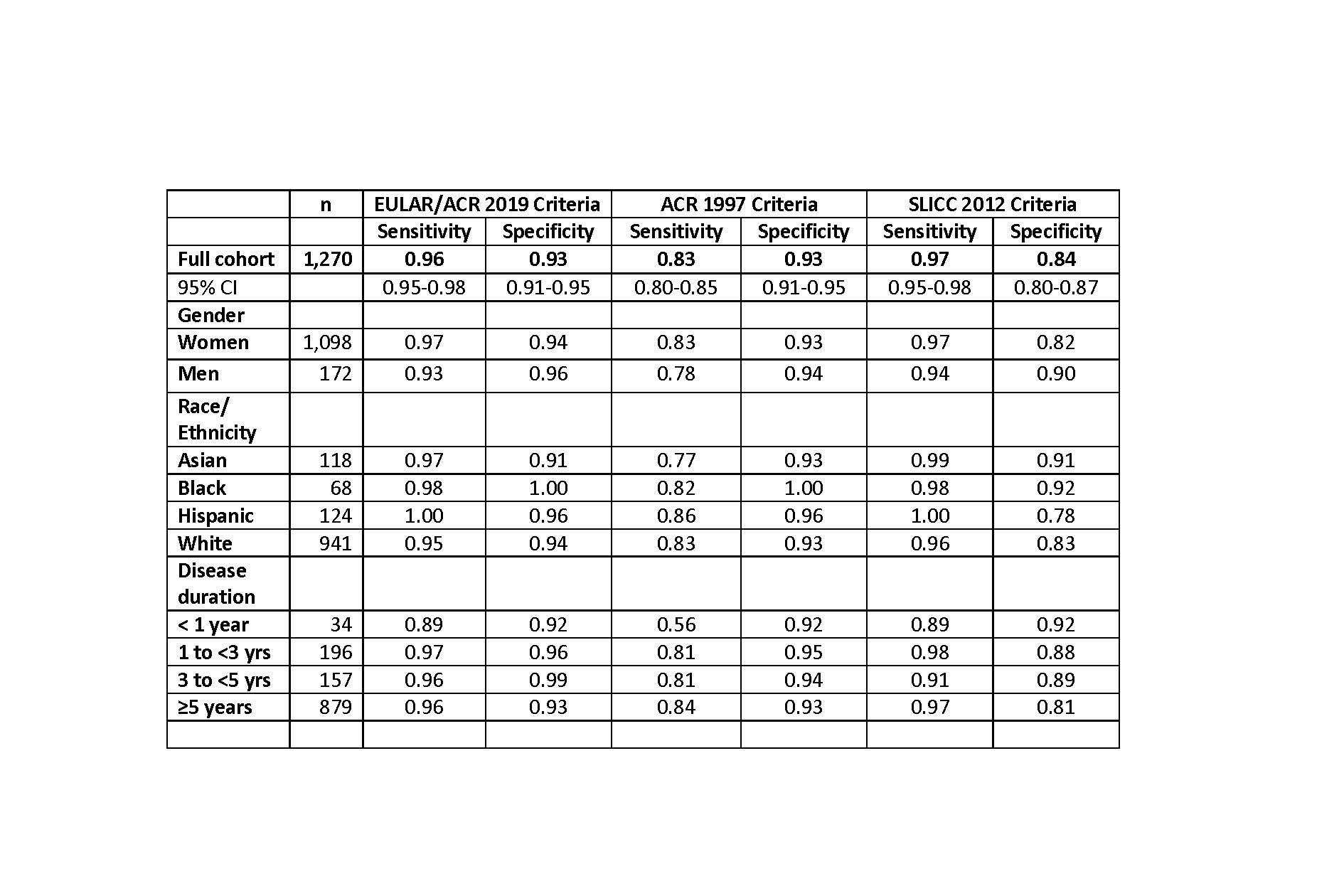Session Information
Session Type: Poster Session (Sunday)
Session Time: 9:00AM-11:00AM
Background/Purpose: The EULAR/ACR 2019 Classification Criteria for SLE have been validated in an international cohort of 696 SLE patients and 574 non-SLE patients with a sensitivity of 96.1% and a specificity of 93.4%. We comparatively evaluated the performance characteristics of the SLE classification systems in subsets of the validation cohort with regard to gender, race/ethnicity, and disease duration.
Methods: 21 SLE expert centers from 16 countries submitted up to 100 SLE cases and 100 SLE mimicking controls each, using a standardized form without knowledge of the new criteria system to form the validation cohort. Cases and control diagnosis (SLE or not SLE) were independently verified by 3 SLE experts. The EULAR/ACR 2019 classification criteria validation cohort consisted of female (n=1,098) and male (n=172) patients; Asian (n=118), Black (n=68), Hispanic (n=124) and White (n=941) patients; and patients with an SLE duration of less than 1 year (n=34), 1-3 years (n=196), 3-5 years (n=157), and 5 or more years (n=879). Sensitivity and specificity with 95% confidence intervals (CI) were estimated for the EULAR-ACR 2019 criteria, the SLICC 2012 criteria and the ACR 1997 criteria.
Results: As shown in Table 1, most of the point estimates for sensitivity and specificity in subsets lay within the 95% confidence intervals of the sensitivity and specificity of the EULAR/ACR 2019 criteria validation. In particular, sensitivity and specificity for all race/ethnicity groups were within the confidence intervals or even higher. Formally, the sensitivity was slightly lower for male patients, corresponding to a higher specificity, but the male 95% confidence intervals (0.86-0.98 for sensitivity, 0.90-0.99 for specificity) overlapped with those of the full cohort. Sensitivity appeared independent of disease duration at least from year 1 on, with all 95% confidence intervals overlapping (for the first year after diagnosis 0.52-1.00 for sensitivity, 0.69-0.97 for specificity).
Conclusion: The point estimates of sensitivity and specificity suggest that the EULAR/ACR 2019 SLE classification criteria perform well in diverse race/ethnicity groups, in men and in early disease. These results now need to be independently validated in larger groups of African American/Black, Asian, and Hispanic patients, male patients and in early disease.
To cite this abstract in AMA style:
Aringer M, Brinks R, Costenbader K, Daikh D, Boumpas D, Jayne D, Kamen D, Mosca M, Ramsey-Goldman R, Smolen J, Wofsy D, Diamond B, Jacobsen S, McCune W, Ruiz-Irastorza G, Schneider M, Urowitz M, Bertsias G, Hoyer B, Leuchten N, Tani C, Tedeschi S, Touma Z, Anic B, Assan F, Chan D, Clarke A, Crow M, Czirják L, Doria A, Graninger W, Halda-Kiss B, Hasni S, Izmirly P, Jung M, Kumanovics G, Mariette X, Padjen I, Pego-Reigosa J, Romero-Diaz J, Rua Figueroa I, Seror R, Stummvoll G, Tanaka Y, Tektonidou M, Vasconcelos C, Vital E, Wallace D, Yavuz S, Naden R, Dörner T, Johnson S. Performance of the EULAR/ACR 2019 Classification Criteria for Systemic Lupus Erythematosus in Men, Diverse Ethnicities, and Early Disease [abstract]. Arthritis Rheumatol. 2019; 71 (suppl 10). https://acrabstracts.org/abstract/performance-of-the-eular-acr-2019-classification-criteria-for-systemic-lupus-erythematosus-in-men-diverse-ethnicities-and-early-disease/. Accessed .« Back to 2019 ACR/ARP Annual Meeting
ACR Meeting Abstracts - https://acrabstracts.org/abstract/performance-of-the-eular-acr-2019-classification-criteria-for-systemic-lupus-erythematosus-in-men-diverse-ethnicities-and-early-disease/

